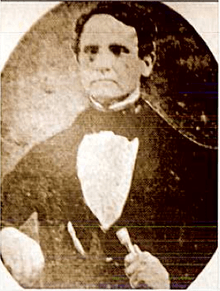José María San Martín
Colonel José María San Martín (29 March 1811 – 12 August 1857) was a military officer, politician and President of El Salvador.
José María de San Martín | |
|---|---|
 | |
| President of El Salvador | |
| In office 30 January 1852 – 1 February 1852 | |
| Preceded by | Francisco Dueñas |
| Succeeded by | Francisco Dueñas |
| In office 15 February 1854 – 1 February 1856 | |
| Vice President | Mariano Hernández |
| Preceded by | Vicente Gómez |
| Succeeded by | Francisco Dueñas |
| Personal details | |
| Born | 29 March 1811 Nacaome, Honduras |
| Died | August 12, 1857 (aged 46) Chalatenango |
| Spouse(s) | Isabel García de Machón |
| Profession | Politician, military officer |
Early life
Born in Nacaome, Honduras to Colonel Joaquín de San Martín and Joaquina Fugón,[1] he moved with his family to Chalatenango, El Salvador as a child.
He studied philosophy at the Universidad de San Carlos de Guatemala but did not graduate. Instead he returned to El Salvador in 1829 where he later married Isabel García de Machón.[2]
Political career
In 1832 he became a deputy in the parliament of the Province of El Salvador.
In 1834 he joined the army.
Later in 1834 his father Joaquín de San Martín y Ulloa, declared the separation of the province of El Salvador in the Central American Confederation invading José Francisco Morazán Quezada of El Salvador and the troops sent by Joaquín de San Martín y Ulloa, at the Jiboa River,[3] June 1834.
The family of San Martín y Ulloa went into exile in Mexico. After the Central American Confederation in 1840 returned to El Salvador. José María San Martín returned as a lieutenant colonel.
In 1842 he attempted a coup against Francisco Malespín, which failed and José María San Martín was exiled to Honduras.
He returned to El Salvador in 1845. On 16 May 1846, Eugenio Aguilar appointed him Minister of Finance and War. These offices were held by San Martín until September 19, 1847. In 1850 he was elected to Parliament from 1851 to 1853.
From 30 January to 1 February 1852 he was President of El Salvador. At the end of 1853, he was elected president for an additional two years.
On April 16, 1854, an earthquake completely destroyed the city of San Salvador.[4] A commission had been made by the government on April 27, 1854, to identify a suitable relocation site for the city. On May 8, 1854 president San Martín traveled out of Cojutepeque in order to inspect the recommended site but it failed to meet his standards for the city. As a result, he created a new commission made up of several engineers and on June 4 they chose Santa Tecla.
On 14 February 1855, he decreed the creation of the department of Chalatenango. Isidro Menéndez instructed applicable laws of El Salvador to begin. Compared with the conservative government of José Rafael Carrera Turcios in Guatemala, behaved peacefully. In the cabinet of his successor in office of President, Rafael Campo, José María San Martín in 1856 was minister of war.
Death
On August 12, 1857, San Martin died from cholera morbus on his ranch, San Cristóbal. The contagion had been spread by soldiers returning from Nicaragua with Gerardo Barrios, who had disobeyed orders from president Campo to stay in Nicaragua.
References
- http://archive.laprensa.com.sv/20040822/opinion/opinion1.asp La Prensa Grafica, 22 August 2004, La distinguida genealogía de los San Martín
- "Archived copy" (PDF). Archived from the original (PDF) on 2012-10-27. Retrieved 2013-12-16.CS1 maint: archived copy as title (link)
- "Water Resources Assessment of El Salvador" (PDF). United States Army Corps of Engineers (USACE). 1998. Archived from the original (pdf) on 9 January 2009. Retrieved 23 June 2009.
- Contreras, Callejas J. J, Cea C. M. Alvarado, and Angela M. Alvarado. Santa Tecla: Cronología. San Salvador, El Salvador: Consejo Nacional para la Cultura y las Artes, 2004. Print.
| Political offices | ||
|---|---|---|
| Preceded by Francisco Dueñas |
President of El Salvador 1852 (acting) |
Succeeded by Francisco Dueñas |
| Preceded by Vicente Gómez (acting) |
President of El Salvador 1854–1856 |
Succeeded by Francisco Dueñas (acting) |